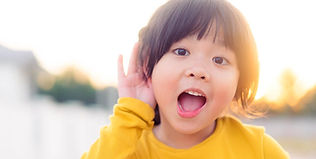Give The Best Support To Your Hearing Loss Child
Learn how you can support and help in their everyday life.

How Common Is Hearing Loss?
32 million children around the world are affected with hearing loss. Approximately 1.4 to 5 out of every 1000 children are born with hearing loss; 60% of these cases are due to preventable causes.
Childhood hearing loss is often identified during newborn hearing screenings that are performed 24-48 hours after birth. However, some children who pass these screenings show signs of loss as they grow older. 1.1 billion people between the ages of 12-35 are at risk of hearing loss due to exposure to noise in recreational settings with 12.5% having permanent damage.
ABR/ASSR/OAE TEST
To know what caused the hearing loss and which part of Ear organ got defect, Infants and Children need objective test including OAE/ABR/ASSR.
After getting the exact test result, they have to get suitable hearing aids or if hearing aids are not effective, they have to get cochlear implants.


Method of measuring the hearing of children.
Hearing loss in children.
ABR / ASSR
Different types of hearing screening tests are used to screen hearing in babies. These tests are safe and comfortable.

OAE (Otoacoustic Emissions)
A cochlea that is functioning normally not only receives sound, it also produces low-intensity, measurable sounds called OAEs. OAEs are absent when an infant/child has a sensorineural hearing loss of 40dBHL or greater. The condition known as “auditory neuropathy/dys-synchrony” is diagnosed by comparing OAE results (typically normal) with ABR results (typically abnormal).

ABR (Auditory Brainstem Response)
The second test is called the auditory brainstem response or ABR. ABR testing is an electrophysiological measurement that allows the audiologist to obtain information about the condition of the inner ear and/or auditory nerve.

ASSR (Auditory Steady State Response)
ASSR testing is another electrophysiologic measurement of a baby’s hearing. The benefit of the ASSR is that the results may provide more frequency-specific threshold information for infants who have severe to profound hearing losses. This enables the audiologist to have more precise data to proceed with hearing aid fittings or determining cochlear implant candidacy.




Warning signs of Children's Hearing Loss
Approximately six out of every 1000 children are born each year with a permanent hearing loss in both ears. If not identified early, a hearing loss can seriously hinder language acquisition and communication development and have a long term impact on educational achievement, confidence and social skills.
Research shows that with early identification of a hearing problem and appropriate support, a child can develop such skills to their optimal potential. The vast majority of these children will lead full, rewarding lives with the use of hearing aids. If your child does not appear to have reached one or more of these developmental milestones at the age indicated, talk to audiologist about having his/her hearing tested.
Book an appointment and consult directly via hotline
0931 010 188
We Have Strong Conviction To Recommend New Next Generation BTE
Try new generation BTE “Trek” for your beloved children.
It is completely different from existing BTE.

Existing BTE use compression method to cut low and high frequency noise, so your children can not hear 250 – 500 Hz low speech sound (m, d, b, n, ng, e, i, u) and 4 – 6 KHz high speech sound (f, th, s) well.

Trek uses SoundDNA platform which solved noise problem completely . Your children can hear all noise-free speech sound and also hear breeze, insect sounds, and music like normal hearing people.


